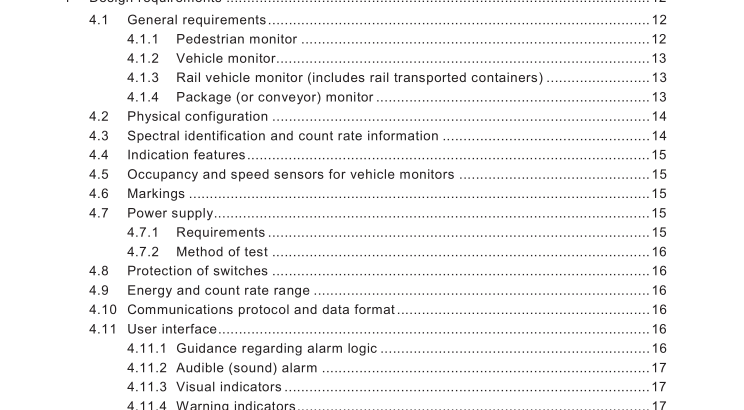BS IEC 62484:2010 pdf download – Radiation protection instrumentation — Spectroscopy-based portal monitors used for the de- tection and identification of illicit trafficking of radioactive material
4 Design requirements
4.1 General requirements The equipment addressed by this standard shall detect the presence of gamma-ray and neutron sources, and identify gamma-emitting radionuclide(s) in objects, containers, vehicles, or in, or being carried by, pedestrians. An alarm shall be activated when the signal from the detection system exceeds an alarm or preset condition (user selectable for radiation level or identification result). Measurement occurs when the object passes through the detection zone or with the object static within the detection zone where the user performs controlled analyses of the object (i.e., enters collection time and/or activates the count). Passage speeds for transient mode testing are stated in Table 1 .
Testing at different speeds may be performed as a special test upon agreement between the manufacturer and user. The manufacturer shall state the time required for static measurements. Monitors shall be capable of operating independently of any peripheral device or remote station and shall be unaffected by any malfunction of a peripheral device. According to their use, spectroscopy-based portal monitors are classified as:
– pedestrian monitor,
– vehicle (including containerized cargo handlers) monitor,
– rail vehicle monitor, and – package monitor (i.e., conveyor). The detection zone is the area located adjacent to a single-sided detection assembly or between two or more detection assemblies where the measurement of radiation takes place (Figure 1 ). The size of the detection zone is based on the classification of use. If a monitor is used in two or more classifications, its detection zone shall be appropriate for each classification. The detection zone shall be of a size that ensures that all objects which could move through the detection zone are monitored.
The manufacturer shall state the size of the detection zone for which the requirements stated in this standard are met. The monitor shall meet the performance requirements of this standard when installed as tested. Operational conditions such as separation distance (distance between opposing detection assemblies) and background radiation shall be considered when installing the monitor. The manufacturer shall state the distance and background level at which the monitor meets this standard. If the manufacturer-stated distance is different from that required by this standard, testing should be carried out at the manufacturer stated distance. It is important to be able to identify the person or vehicle that caused an alarm. The alarm should be generated within a period of time to ensure that the object that caused an alarm can be identified. This is important if complex algorithms are in place that need a finite process time. It becomes more important if a constant stream of traffic is being monitored (i.e., pedestrians).
4.1 .1 Pedestrian monitor Pedestrian monitors shall provide a detection zone to ensure that people are monitored. For evaluation purposes, the height of the detection zone shall be 1 ,9 m measured from 0,1 m above the ground. The recommended distance between detection assemblies for evaluation purposes is listed in Table 2 or provided by the manufacturer for monitors where each detection assembly is part of a structure with a fixed distance between each assembly.
Pedestrian monitors may use a single detection assembly (single-sided) or multiple opposing detection assemblies with or without detectors across the top and/or bottom part of the detection zone. For monitors with a restricted passage height, the height of the detection zone shall be from the ground or base surface to the top surface of the monitors’ detection assembly. The passage speed for transient mode testing shall be the speed listed in Table 1 .
4.1.2 Vehicle monitor Vehicle monitors shall provide a detection zone that ensures that the entire vehicle is monitored during passage when operated in transient mode. The height of the detection zone shall be stated by the manufacturer.
